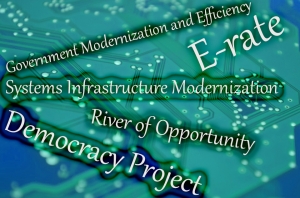
A recent survey that graded states on their tech portfolios revealed something very interesting. The news is good for technology firms – it appears that most levels of government are about to begin upgrading old legacy systems through modernization efforts. Information technology experts have long questioned why government moved so slowly to replace and upgrade technology. The argument that the funding was simply not available did not ring true to those who knew how quickly and significantly technology could reduce costs while creating efficiencies. That claim seems to be true more often than not.
One program that is held in high regard is Michigan’s “River of Opportunity” initiative. This project focused on gaining efficiency and thereby cutting costs. And, the system that was developed turned out to be good for both citizens and public officials. The program displays graphical imagery collected by the state and the system can be accessed by 29 counties. The technology initiative has already saved more than $3 million in state revenue. This modernization program feeds data into the system efficiently and with little cost because the state’s police, transportation and environmental departments all embraced sensors that are integrated within the Internet of Things. Simply put, the data flows from disparate systems to a central location where it is consolidated and made available for government officials as well as the public. The modernization effort has been deemed a great success.
 Because of the success of projects like this, and particularly the aspect of reducing expenditures, public officials everywhere are looking for ways to use technology in new ways.
Because of the success of projects like this, and particularly the aspect of reducing expenditures, public officials everywhere are looking for ways to use technology in new ways.
Idaho recently announced an initiative known as the Idaho Systems Infrastructure Modernization project. State officials have estimated the cost to be around $102 million, including a $10 million to $12 million contingency for staffing; and agency interfaces to the new system.
New York’s governor announced a plan to modernize the state’s voting system, an initiative he says is long overdue. The Democracy Project will streamline voter registration services, remove unnecessary voting barriers and increase accuracy in all aspects of the voting process. The modernization program does not yet have a price tag but will likely be implemented before the 2018 election.
The State of Missouri is modernizing a number of very large systems. Modernization projects will include technology systems related to Medicaid eligibility and enrollment, the state’s integrated revenue system and the unemployment insurance system. Numerous tax systems will also be updated and modernized.
Vermont has been a leader when it comes to modernization and has established a Government Modernization and Efficiency Team. The team will guide the development of a digital strategy. It will also oversee development of a private cloud, numerous mainframe upgrades and a new data center. The state also plans to modernize its tax management system.
The governor of Arizona has recommended spending $56.4 million on a number of technology modernization projects. He wants to allocate $5 million to expand broadband access to some rural school districts and supplement that funding with E-rate funding from the federal government. The governor also wants the Department of Revenue to modernize its data centers and he hopes to replace the state’s child welfare data system.
Texas, a state with a multi-billion-dollar information technology budget, has a CTO who hopes to begin modernization efforts that will benefit all agencies, not just those with old technology.
These planned modernization projects should definitely make technology firms happy. And, taxpayers will smile when the projects are completed and costs begin to subside.
